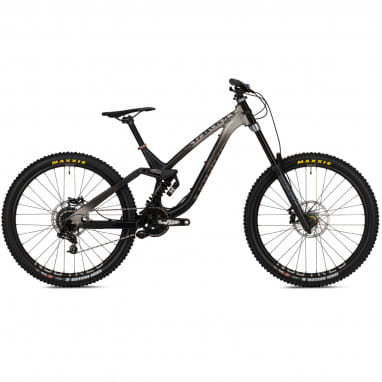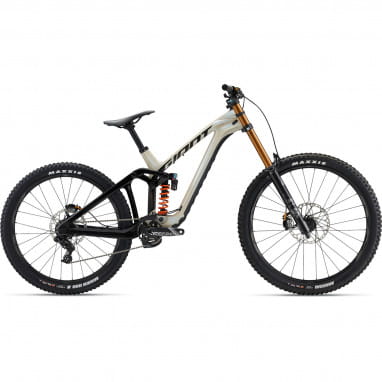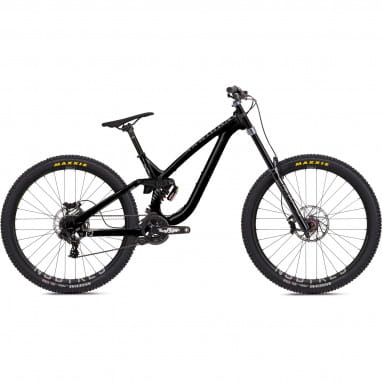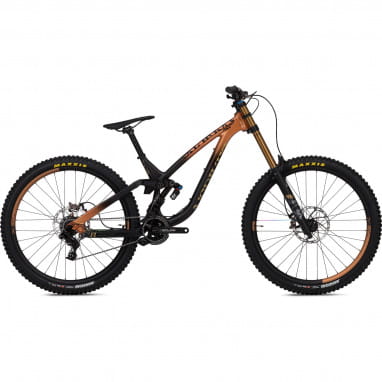Downhill is, according to legend, the discipline where mountain biking originated. Somewhere in America (where else?) in the 70s, a few crazy people were plodding down the mountains on their bikes. The bikes were in shambles afterwards, because there were no off-road bikes sturdy enough for such lousy treatment back then. Fortunately, the riders survived, somehow making it home to invent the off-road bike in the garage - so the MTB was born. And at the same time, the full-can-down-the-hill-hutting, today also called downhill.
1. Is it downhill with you?
A downhill bike is a mountain bike like any other, at most a little more robust, you might think. But it isn't. Mountain bikes are, above all, versatile. They go everywhere, on any surface, in any weather, uphill and downhill. A downhill bike is also versatile, it gets around on any surface, on any terrain, in any weather. But not uphill. Transmission and frame design are built for a lot of speed, they bring agile handling and a stable ride, yet a DH bike prefers to roll down the slope, for the way to the entry you need a shuttle service or the lift.
Downhill bikes are robustly processed, frame material and components are the best and most durable, which are to be had for money, everything else would make with these requirements directly the Grätsche. And there it almost does not matter whether you just want to spend a cozy day in the bike park, or whether downhill is a racing discipline for you, the bikes are built to withstand action of all kinds.
2. Downhill bikes deliver a lot of speed with a lot of control
.
Downhill is not only rough, DH is also fast. Logical really, after all you don't have to rely on your calves alone, gravity does the rest. However, it works a little differently than a normal "fast bike". While other bikes are built so that the rider can build up speed at best (for example, racing bikes), downhillers hold the high speed at best and remain stable while riding. So you don't lose control of your bike at so much speed, DH bikes are built even more than other mountain bikes to be perfectly controlled by the rider.
Thanks to driving posture and frame design, you have over your DH bike anytime best control, even if airtime, hairpin turns, jump tracks or steep descents are pending. The fairly long wheelbase brings smoothness in the driving behavior, so you can control your bike sovereign and safe through the hairiest turns.
3. plenty of suspension travel
More is more, at least when it comes to the suspension travel on the downhill bike. Suspensions go with 200mm or 220mm to the start, also the forks bring it to similar values. This makes the Fully - as promised above - schluckfreudig, even on rough ground. It provides traction and traction, which is important for the control sung about under 2. In addition to the driving characteristics, a long-stroke bike with progressive damping in the terrain is also a protection for your spinal discs. The better the suspension and the more sensitive its response, the less you get of the quality of the ground, the dampers iron away everything in front of you.
4. 27.5 or 29 inches?
For a long time, the wheel size 27.5 was the standard for DH bikes, because the advantages of 29ers actually pulverize themselves directly at the entrance of the descent. Smooth running, for example, is all well and good. But if you want smooth running, you usually don't ride downhill. Efficiency is also less necessary when it goes permanently downhill. But the agility, agility and playful handling of the smaller wheels is a real advantage in technical terrain. Today, however, more and more manufacturers are offering the option of sending 29 inchers down the mountain. The faster rollover behavior and stability are here an advantage from which all can benefit, in addition, the bikes are ideally suited for large bikers, and therefore mounted on larger frame sizes.
On downhillers can also be found Mullet setups, so 29 inches in front and 27.5 behind. So you can use the advantages of both wheel sizes, the large front wheel brings smoothness and the good rollover properties, the smaller rear wheel makes the bike more agile.
5. Robust bikes for aggressive downhill
The mountain bike sport itself is already really nix for the faint of heart, but downhill puts one more on it. Jumps, gaps, loose ground and in addition the breakneck speed, which arises almost by itself when going downhill ... Here is really everything demanded of man and material. Therefore, you should generously stock up on our protectors. If neckbrace, full-face helmet and protector jacket are justified somewhere, then in the DH!
But we actually wanted to introduce DH bikes here, so back to business: downhillers are not filigree beauties, they are usually real lumpers. So that the frame survives the many action unharmed, he brings much material, both carbon and aluminum offer themselves here. Large tube diameters and slightly more wall thickness make the frames not only torsionally stiff, but also durable and shatterproof. While on other MTBs so some rear construction of weight optimization because of years out is, you will find downhill bikes still as a single-joint, multi-joint or four-joint, depending on what the manufacturer considers break-proof and drive-neutral.
Thick tires provide good ground contact. Huge braking systems are your life insurance. Unlike other mountain bikes, many downhillers still have double-bridge forks that can take the beating your trail dishes out. Only the most durable components make sense, all in all, this adds up to quite a bit of material.
Thick suspensions and sturdy frame construction - Downhill bikes are anything but featherweights, expect 16kg and more. This is also one of the reasons why the bikes are excellent downhill, but uphill do not really work well. The weight is necessary, but just not efficient. But they also do not have to, after all, downward always pushes the force of gravity with.
6. who brakes is afraid ... nevertheless there are fat brakes on the DH bike
.
A downhill bike brings the usually best, what brake manufacturers have to offer so. From a DH without an excellent braking system you should leave the fingers! Here, disc brakes are mandatory, it is best hydraulic, because they are well dosed and smooth enough that you do not fall off after the first descent the handles. Brake discs with large diameters of up to 200mm or 220mm put away the requirements, 4-piston calipers bring enough bite with.
7. Why is it not uphill?
A downhill bike is a specialist for descents, for various reasons everything else works with such a bike rather poorly. But why? It's actually quite simple. To plow cleanly up a slope with a bike, it must be efficient. The many suspension travel is absolutely necessary for descents, but not powerful enough for everything else. The geometry is also not really helpful here, the flat head tube angle positions the front wheel in front of the driver, so results in enough stability on fast descents, slower speeds, touring and uphill are rather not in it, also transmission and seat position are not suitable for this. Last but not least, the weight of the bike would be a real drag if you don't roll downhill.
8. Buy downhill bikes online
.
All in all, downhill bikes are pure fun and always good for a decent adrenaline rush, but their area of use is still quite limited. If you don't want to limit your radius to downhill slopes, there's an excellent alternative that can put away similar descents, but additionally climbs willingly and is also fun on flat terrain, just check out the Enduros here in the online store! Other fullys are also fun off-road, trail bikes and AM bikes are the most versatile here and deliver a good mix of propulsion and off-road, marathon MTBs and touring fullys like to go fast, and without any help from gravity. Since you've landed here with the downhill bikes, we probably don't need to tell you about hardtails, unless you're looking for a simple, cheap alternative for every day.



